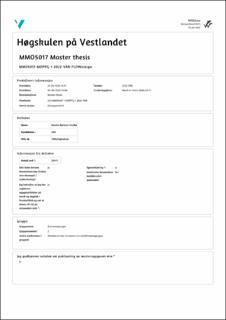| dc.description.abstract | In this master`s thesis a modelling of a floating aquaculture facility and delousing vessel has been carried out using the state-of-the-art analysis software AquaSim, by Aquastructures. Of these models, various analyses have been performed. The purpose of the master`s thesis is to investigate the potential impact a moored service has on the modelled aquaculture fish farm mooring system and how we can use the results from modern analysis software to execute a weather availability and weather window analysis and a risk assessment. The procedure for answering the predetermined research questions was to predefine some cases. The first case includes a static analysis of the system. The second, third and fourth case includes a mooring analysis with and without a moored vessel, and when the two most utilized mooring elements is assumed broken. The results from case 2 and case 3 shows that by mooring a large service vessel alongside the floater with the most utilized mooring lines there is an increase in the axial force in mooring line 15 to mooring line 18, and the bridle ropes and grid ropes connected to the floater named M4 and the buoy strap belonging to buoy A5. The ropes with the greatest increase in axial force were identified as the buoy strap, bridle rope and mooring line 18. The difference in axial force of the two cases shows an increase 14% in the bridle rope, 14% in the grid rope and 7% in mooring line 18.
The fourth case involved looking at the impact of failure in the most utilized mooring lines has on nearby mooring ropes. The most utilized and the ones found critical to the aquaculture fish farm were identified as mooring line 18 and grid rope A4-A5. For the first analysis we looked at what the impact were when mooring line 18 went to failure. When mooring line 18 went to failure the result showed that the load this line carried were allocated amongst the bridle rope, mooring lines, grid rope and the increase in axial force in these ropes where 45%, 13%, 58% and 47% respectively. Grid rope and buoy strap was relived due to the breakage and experienced a decrease in axial force of -24% and -9%.
When grid rope A4-A5 went to failure the results show a significant increase in axial force in the hen foot located underneath the service vessel. The axial force in the hen foot experienced an increase of 146%. Mooring line 17, 18 and attached anchor chain experienced a decrease in axial force along with buoy strap A5. The mentioned moorings decreased by 5%-8%. The results also show that the mooring lines attached to the other three floater did not experience any increase in axial force worth mentioning.
Based on the results from case 2, case 3 and case 4 it was concluded that, although overall minor increase in axial force in the mooring system belonging to floater 4, a mooring analysis should include an evaluation of the impact a large service vessel has on the mooring system.
In addition to the analysis of the degree of utilization of the mooring lines with and without a moored service vessel present, several hydrodynamical analysis were executed. The hydrodynamical analysis investigated the motions of the service vessel when exposed to irregular waves. The RMS
values for lateral- and vertical acceleration and roll and pitch calculated of the service vessel hull is compared to the established NORDFORSK, 1987 values (Appendix C). The analysis shows that when the vessel was influenced by a sea state consisting of significant wave heights of 2.0 meters, corresponding wave period of 7.0 seconds and a wave direction of 89°, the limiting factor was lateral acceleration in x-direction. When the vessel was exposed to waves heading from 135°, significant wave height equal 2.0 meter and corresponding wave period of 9.0 seconds the limiting factor was also lateral acceleration in x direction. There were no sea states which led to an exceedance of the RMS in roll in the vessel from these directions, and therefore one final analysis was executed with irregular waves progressing from 175°, significant wave height 2.4 meters and wave period equal to 5.5 seconds which led to roll motion exceeding the recommended RMS values for a safe and effective work environment. From these results three operational limiting sea states criteria where established and used in the next scope of the thesis which includes a weather availability analysis and a weather window analysis. These analyses were performed using the alpha factor method and weather criteria and availability analysis often used in the oil and gas, and offshore wind industry The thesis ends with a risk assessment of a large service vessel during a delousing operation where probability, consequence and risk acceptance criteria are established based on the findings in the thesis. | en_US |

